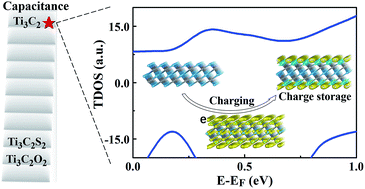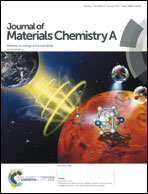Origin of theoretical pseudocapacitance of two-dimensional supercapacitor electrodes Ti3C2T2 (T = bare, O, S)†
Abstract
MXenes are experimentally proved to be one of the promising supercapacitor materials; nevertheless, the theoretical limit of their supercapacitance and its redox origin are not accessible yet, which largely inhibits the future explorations on MXenes to be applied in the capacitors. Here, via first-principles calculations and our developed rigid band approximation (RBA), we systematically investigate charged electrodes Ti3C2T2 (T = bare, O, S) to reveal a theoretical limit of supercapacitance and the relevant origin of the capacitance. It is found that the theoretical gravimetric capacitance value of pure Ti3C2 surprisingly reaches 2131 F g−1 due to the high continuous density of states near the Fermi level (EF) and large difference of electronegativity between surface atoms and solvent ions. When considering the groups O and S with H coverage from 0 to 100%, we note that these groups significantly suppress the density of states around EF, i.e., the capability of storing charge. To explore the ion binding influence on the capacitance, the phase diagram of hydrogen binding energy and capacitance is provided for the screening and optimization of the next generation of electrode materials. These findings offer a comprehensive understanding of the supercapacitance of MXenes and guidance of further improvements of the capacitance in realistic charged environments.



 Please wait while we load your content...
Please wait while we load your content...